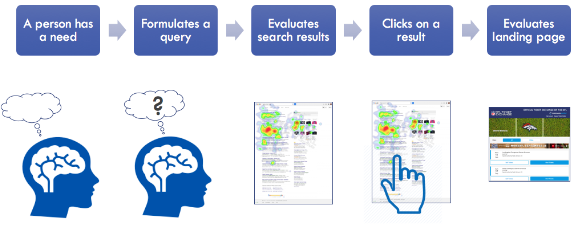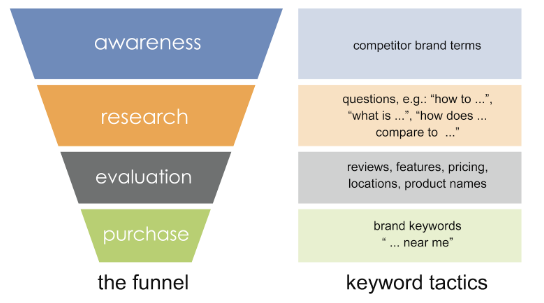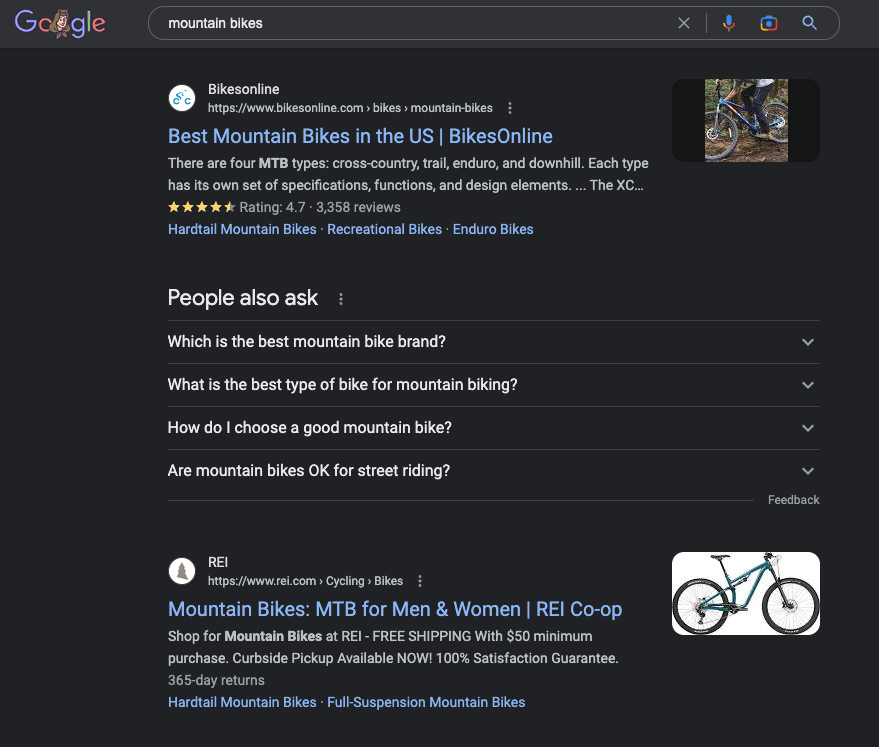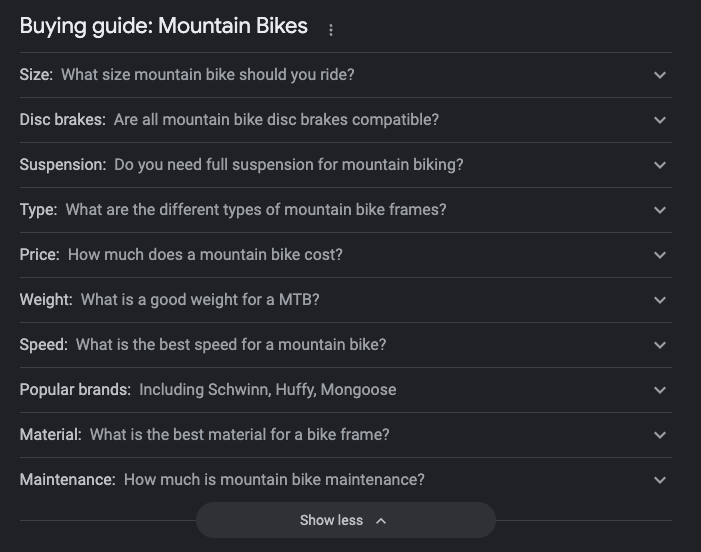Marketers know the importance of targeting keywords so that users can easily find our content on the web — but it’s not as simple as that. We also need to consider search intent.
What is search intent?
Search intent is the reason someone conducts a search — are they looking for information on a particular topic? Do they want to read reviews of local restaurants? Are they ready to make a purchase?
There are infinite reasons why users search for the things they do, but in the digital marketing world, we classify search intent in four ways.
Types of search intent
1. Navigational search intent
Navigational intent occurs when a user knows the brand or website they’re looking for, but doesn’t know (or doesn’t feel like typing) the domain name. For example, a user might search for “The Bike Shoppe” on Google rather than plugging https://www.thebikeshoppe.com/ into the address bar.
Navigational searches are often associated with the awareness stage — and they also imply brand awareness.
2. Informational search intent
An informational search occurs when a user is looking to learn about a topic. For example, “how to tune up a mountain bike” or “where to go mountain biking.”
Users conducting informational searches are usually in the research stage.
3. Commercial search intent
A commercial investigation search typically involves a user looking to compare products, find reviews of service providers, or see a list of the top options in a specific category. “Best mountain bikes of 2023,” “compare Fuel EXe 9.9 XX1 AXS and Rail 9.9 XX1 AXS Gen 4,” and “reviews of Trek bikes” are all commercial searches.
Commercial investigation queries occur during the evaluation stage.
4. Transactional search intent
Transactional searches are exactly what they sound like — a user is looking to complete a transaction. Searches might look like “buy Trek bikes near me” or “Trek bikes for sale in Denver.”
It goes without saying that these searches happen when users are ready to purchase.
Why search intent matters
The job of a search engine is to serve users the most relevant results for their queries. The job of a search marketer is to create content that successfully ranks for those queries. If we marketers aren’t taking the intention behind a search into account, we simply won’t rank — not to mention, our content won’t help our users (or move them down the funnel).
The anatomy of a search
Search intent directly correlates with the wants, needs, or pain points of a user — what are they looking for? What content will fulfill their needs or solve their problems?
Check out the visual below for a look at the flow of a search (and what happens thereafter).

If we’re lucky enough to get users landing on our site, then we’re off to a great start — but if they determine what we’re serving isn’t satiating their appetite, they’ll hit the back button and try again. And not only have we lost the user as they bounced off the site, we’ve given a signal to the search engine that our page doesn’t match user intent for that search keyword, potentially lowering our ranking for that keyword.
A mismatch in search intent and page content can be a key reason for drops in organic conversion rate on a particular webpage, too.
That’s why it’s so crucial to fulfill search intent, not just target keywords.
More examples of search intent
Let’s walk through each type of search intent as it pertains to the buyer’s funnel.

As an example, let’s use mountain bikes as our topic. Joe, our searcher, may start his journey by plugging in some popular brand names, such as “Santa Cruz mountain bikes.” At first, he has a navigational intent, because he was looking to begin his search by visiting the Santa Cruz website.
But after looking at the results, Joe isn’t really sure which bike is right for him. So maybe he types in “How to choose a Santa Cruz bike.” There’s informational intent.
From there, he’s narrowed down his options to two bikes. He then searches for “Santa Cruz Enduro Bikes reviews” and/or “compare Santa Cruz Tallboy bikes and Santa Cruz Hightower bikes.” That’s commercial investigation intent.
Finally, Joe is ready to make his purchase. He then searches for “buy Santa Cruz Trail Bikes near me.” At last, transactional intent.
Joe has hit every type of search intent and moved successfully through the funnel. Of course, the movement down the funnel isn’t always so smooth and linear; not to mention, we didn’t even touch on the length of time it took Joe to get to the purchase stage.
How do you determine search intent?
Here’s where the real work begins. The intent behind some keywords is pretty clear — check out the table below for an easy way to spot intent based on the words included in a query.
Navigational | brand or domain name, product name, service provider name |
Informational | tutorial, how to, what is, examples, who is, where is, why is, guide, ideas, tips |
Commercial | top, best, reviews, compare |
Transactional | buy, _____ near me, order, purchase, coupon |
It’s not always that clear-cut, though. What do you think the search intent behind “mountain bikes” is? Does the user want to buy a mountain bike? See photos of mountain bikes? This is where SERP analysis comes in.
Conduct a search for the keyword in question and see what comes up. What you find will tell you how the search engine perceives the search intent for that query.

Looking at the SERP for “mountain bikes” shows us that even Google isn’t entirely sure of what the searcher is looking for — so they display Shopping results, a list of the best mountain bikes in the US, and a major retailer’s mountain bikes category page. They also include a buying guide SERP feature.

What’s the takeaway here? Broad keywords usually have a muddy search intent — marketers without the benefit of brand awareness (like REI has) are better off targeting more specific, long-tail keywords with clear search intent.
How to use search intent to guide your content development
Think back to our example of Joe the mountain biker. What marketers should consider here is how to create diverse content for each of the keywords in his journey and his unique search intent — we need to make sure he knows we sell Santa Cruz bikes, but we also need to help him choose the best bike for him, compare his options, let him read real-world experiences from purchasers like him, and make the buying process as easy as possible.
As you develop new content ideas, don’t forget to incorporate search intent. It’s a key way to ensure your ideas reach consumers and keep them sticky on your website.
As you develop your content strategy, don’t leave search intent out of the equation. If you need help, reach out! We’d love to hear from you.


